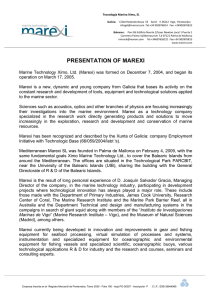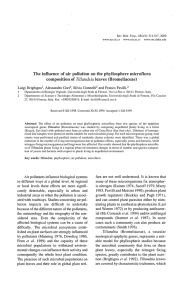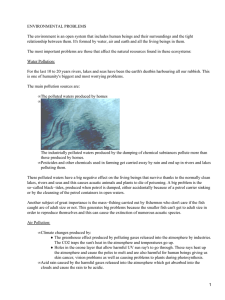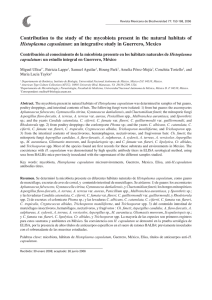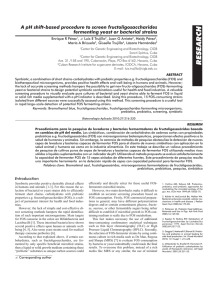ecology and taxonomy of yeasts isolated from various marine
Anuncio
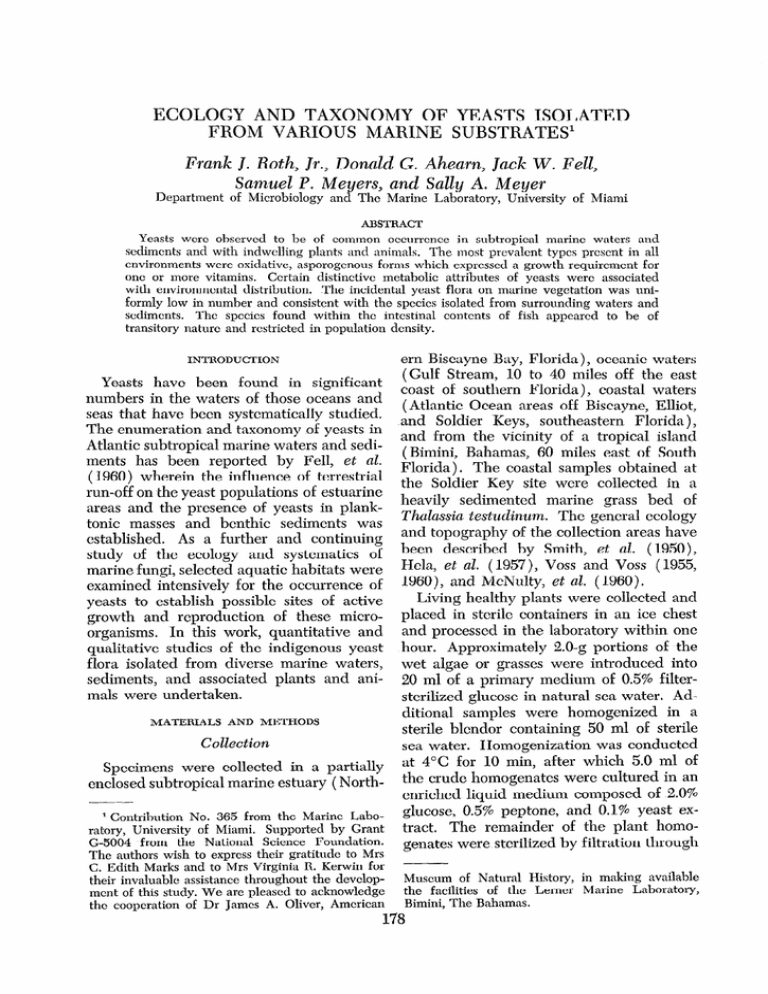
ECOLOGY AND TAXONOMY OF YEASTS ISOLATED FROM VARIOUS MARINE SUBSTRATES Frank J. Roth, Jr., Donald G. Ahearn, Jack W. Fell, Sarnuel P. Me yew, and Sally A. Meyer Department of Microbiology and The Marine Laboratory, University of Miami ABSTRACT Yeasts wcrc observed to be of common occurrence in subtropical marine waters and scdimcnts and with indwelling plants and anilnals. The most prevalent types prcscnt in all environments were oxidative, asporogcnous forms which expressed a growth requircmcnt for one or more vitamins. Certain distinctive metabolic attributes of yeasts were associated with environmental distribution. The incidental yeast flora on marine vegetation was uniformly low in number and consistent with the spccics isolated from surrounding waters and scdimcnts. The species found within the intestinal contents of fish appcarcd to be of transitory nature and restricted in population density. Yeasts have been found in significant numbers in the waters of those oceans and seas that have been systematically studied. The enumeration and taxonomy of yeasts in Atlantic subtropical marine waters and sediments has been reported by Fell, et nl. ( 1960) wherein the influence of terrestrial run-off on the yeast populations of estuarine areas and the presence of yeasts in planktonic masses and benthic sediments was established. As a further and continuing study of the ecology and systcmaties of marine fungi, selected aquatic habitats were examined intensively for the occurrence of yeasts to establish possible sites of active growth and reproduction of these microorganisms. In this work, quantitative and qualitative studies of the indigenous yeast flora isolated from diverse marine waters, sediments, and associated plants and animals were undertaken. MATERIALS AND Ml~ITIODS Collection Specimens were collected in a partially enclosed subtropical marine estuary ( North-’ Contribution No. 365 from the Marine Laboratory, University of Miami. Supported by Grant G-5004 from the National Science Foundation. The authors wish to express their gratitude to Mrs C. Edith Marks and to Mrs Virginia R. Kerwin for their invaluable assistance throughout the devclopmcnt of this study. We are pleased to acknowledge the cooperation of Dr James A. Oliver, American ern Biscayne Bay, Florida), oceanic waters (Gulf Stream, 10 to 40 miles off the east coast of southern Florida), coastal waters (Atlantic Ocean areas off Biscayne, Elliot, and Soldier Keys, southeastern Florida ) , and from the vicinity of a tropical island (Bimini, Bahamas, 60 miles east of South Florida). The coastal samples obtained at the Soldier Key site were collected in a heavily sedimented marine grass bed of Thdzssia testudinum. The general ecology and topography of the collection areas have been described by Smith, et nl. (1950), Hcla, et al. ( 1957)) Voss and Voss ( 1955, 1960), and McNulty, et al. ( 1960). Living healthy plants were collected and placed in sterile containers in an ice chest and processed in the laboratory witbin one hour. Approximately 2.0-g portions of the wet algae or grasses were introduced into 20 ml of a primary medium of 0.5% filtersterilized glucose in natural sea water. Additional samples were homogenized in a sterile blcndor containing 50 ml of sterile sea water. Homogenization was conducted at 4°C for 10 min, after which 5.0 ml of the crude homogenates were cultured in an enriched liquid medium composed of 2.0% glucose, 0.5% peptone, and 0.1% yeast extract, The remainder of the plant homogenates were sterilized by filtration through Muscum of Natural History, the facilities of the Lemer Bimini, The Bahamas. 178 in making available Marine Laboratory, YEASTS ISOLATED FROM a MilliporeO HA2 (porosity 0.4 p) mcmbrane. The sterile extracts were kept frozen and subsequently tested as sources of carbohydrates for yeast growth and assayed for antibio,tic activity for yeasts. Invertebrates were collected and returned to the laboratory in a viable state, The animals were dissected aseptically and gut contents inoculated into the glucose-sea water medium. Small invertebrates of less than 20 mm in length were washed individually for 10 min in each of 7 baths of sterile sea water. The washed organism was then placed in the enriched liquid medium. The rinse waters used in the cleansing process were subsequently cultured for yeasts. Fish were killed and a one- to, two-inch section of the intestine was removed aseptically and placed in a glucose-sea water medium. In the initial collections, fish taken from the Biscayne Bay area were housed temporarily in large tanks for l-3 days before dissection. Subsequently, all fish were maintained in the live-well of the ship and were dissected within 2 hr of collection. Sediments from the algal and invertebrate collection sites were mixed with sterile sea water, shaken thoroughly, and the heavier particles permitted to settle. The clo,udy supernatant from the sediment mixtures and sea water from the same locales were filtered by standard membrane-filtration technique (Goldberg, et nl. 1952, Hass 1956) to isolate yeasts. Water samples from deep-water regions were collected with a van Doren sampler and tither filtered aboard ship or rcfrigerated and returned to the laboratory for processing. Isolation and Identification All primary cultivations of algal, grass, invertebrate, and vertebrate samples were conducted in Erlenmeyer flasks situated on a Gyrotory shaker rotating at 55 rev/min at 22” to 24°C. A LO-ml portion of the liquid from these cultures was inoculated 2 Registered trademark Milliporc tion, Bedford, Mass. Filter Corpora- AMARINE 179 SUBSTRATES daily onto an enriched solid sea water modium containing 1.0% glucose, 0.5% peptone, and 0.1% yeast extract. Milliporc membranes employed for the direct isolation of yeasts from water, sediment and plant washings were incubated on the aforemcntioned solid medium. Bacteria were controlled by antibiotics and/or acid pH ( Fell, et n2. 1960; Fell and van Uden 1962). Over 900 representative yeasts, differentiated on the basis of colonial morphology, were selected and placed in pure culture from the enriched agar plates and incubated membranes. Taxonomic identification procedures followed those recommended by Lodder and Kreger-van Rij ( 1952) and Wickerham ( 1951). An expanded number of carbon assimilation tests, employing more than 30 compounds, were conducted under constant agitation using a Gyrotory shaker (Ahearn, et nZ. 1960) or a ro,ller drum. The vitamin and amino acid requirements of selected marine yeasts isolates were determined and are presented in detail in a separate publication (Ahearn and Roth 1962). RESULTS The most common yeasts encountered were species of Rhodotorula, Candid& Trichosporon, Debaryomyces, and CryptococCUS. The population frequencies of these organisms in the diverse marine environs examined are presented in Table 1. Yeasts were isolated from 78% of the water and sediment samples. The average population densities of estuarine, coastal, and oceanic waters were under 100 cells /L. Candida tropic& and Rhodotorula ( muciZaginosa) rubra were the most common and widespread species in estuarine areas, whereas, C. parapsilosis and R. rubra OCcurrcd in the majority of coastal locales. The most ubiquitous yeasts in oceanic waters proved to be C. parapsilosis and Debrayomyces kloeckeri. Heaviest yeast populations were observed in water samples taken from grass flats, zones directly influenced by terrestrial runoff, and in one collection from the Gulf Stream. In marinc areas directly affected by fresh water influx and those subjected to 180 TABLE FRANK J. ROTH, 1. Frequency of isolation of yeasts from various marine environments and substrates Nature and type of samples Waters and sediments Algnc and grasses Fish Crustaceans Lower invertcbra tes No. of No. of samples genera cultured examinrcl -___ 220 47 80 137 14 --.------ 11 14 10 8 Samples with yeasts (%) 78.0 52.0 61.0 14.0 57.0 heavy recreational bathing (Northern Biscayne Bay ) , population densities ranged from less than 10 to approximately 4,600/L. In these environments species of Can&da and Rhodotorulu, represented mainly by C. tropicalis, C. guilliermondi, and C. parapsilask, and R. rubm, comprised about 75% of the yeast population. Similarly, the shallow, sheltered lagoon water of Bimini possessed comparable speciation patterns with populations ranging from less than 10 to 1,260/L. Yeast counts in marinc grass flats ( Soldier Key) varied from 300 to 5,900 viable cells/L. Well over 65% of these isolates were species of Rhodotorula and Cryplococcus, with R. pilimanne and R. rubra being the predominant forms. Open ocean waters generally contained the lowest numbers of yeasts. In these regions, the most ubiquitous species were C. parapsilosis and D. kloeckeri. In such waters the total yeast counts rarely exceeded 2,500 cells/L. The maximal offshore population observed, 5,200 cells/L, occurred in the Gulf Stream 15 miles east of the coast of South Florida. This population peak was composed of about 60% R. grnminis and was observed at a depth of 160 m. Populations of 2,000 to 3,000 cells/L, with similar speciation, were found at depths below 160 m and to 400 m. Surface water from this site showed only 200 cells/L and contained almost exclusively a thiamine-requiring strain, R. glutinis var. duiriensis (Hasegawa 1960). This taxon was not isolated from water samples collected below 30 m. With rare exception, water samples from all collection areas including those apparently devoid of yeasts, yielded isolates of black, yeast-like organisms, which were con- JR., ET AL. sistent with the ill-defined genus Pullu7.aria (Syn: Dematium, Aurobasidium) . DALIteromycctes mainly species of Aspergillus, Penicillium, Hyalopus, Spicaria, and Cladosporium ( Hormodendrum), were quite common in organic materials and sediments, but occurred less frequently in water samples. Phycomycetes, when isolated, generally were strains of the genus Syncephalnstrum. Additional collections taken at random intervals in certain areas demonstrated that the speciation and population of yeasts and molds within a given environment are highly variable. The marine vegetation examined included representatives of the genera Padinn, Udotea, Batophora, Penicillus, Laurencin, Halimeda, Caulerpa, Sargassum, Ulna, Cymodocea, and Thalassia. In contrast to the apparent widespread presence of yeasts in the surrounding waters and sediments (Table 1)) only 52% of the algal and grass samples demonstrated yeasts. Definitive association between particular yeasts and a higher marine plant species was not noted. Individual samples oE marine vegetation generally yielded only one or two species of yeasts, whereas in the immediate waters thousands of cells per liter, commonly representing 6 or more species, were present. In order to obtain yeasts from whole living algal and grass sections, prolonged periods of incubation of 6 to 10 days were required. This may be due to very low initial populations, unsuitability of the natural substrate, or the presence of inhibitory materials associated with the plants. Attempts to isolate yeasts from the crude homogenates prepared from the living algae were unsuccessful. The yeast taxa in the fungal growth from intact vegetation appeared to reflect, in part, the speciation observed in adjacent water and sediments. Sterile filtered algal homogenates of Batophora sp., Udoten sp., Penicillus sp., and Laurencia sp. were individually employed as potential carbohydrate sources in medium. an otherwise complete liquid These filtrates, in a wide range of concentrations, supported only negligible to fair growth of five common marine-occurring YEASTS TABLE 2. Gmr-t Collection area ISOLATED Occurrence FROM 8lX%XS 181 SUBSTRATES of fish of yeasts in the intestines No. of spccimcns with yeasts No. of specimens studiccl of 1 Estunrinc and coastal MAINE 22 1 1 17 1 1 T. C. C. C. R. R. H. D. II. Haemulon Stenotomus Ocyurus Anisotremus Lachnolainus 15 LO 4 1 1 10 4 2 0 0 R. minuta* C. parapsilosis R. glutinis Ilaemulon Lutjanus Sphyraenn Seriolu Bulistes Malucanthus Halichoeres Holocentrus Carann Anisotremus Unidcntificd -.-- 4 8 1 _----- Tropical island(Bimini, The Bahamas ) ( 1961) ----* Most - -__------common spccics yeasts Haemulon Carana Anisotremus ( Biscayne 13ay, Florida ) Tropical island(Bimini, The Bahamas ) (1960) Idcntifixdion - ---. - -- E 1 1 1 2 1 2 _- - _ _ _______0 6 0 2 -__ --- : 1 0 0 1 2 cutuneum* parapsilosis guilliermondi tropic& rubru pilimanue anomala kloeckeri valbyensis -___ - - -----C. tropicalis* R . pilimanue Torulopsis spp. C. parapsilosis ------ present. yeasts, In one case, a 5% concentration of the extract from Batophora sp. markedly restricted the growth of Cryptococcus albidus. This effect was overcome by organic enrichment of the medium including the addition of glucose. Of the marine teleosts examined, 61% contained yeasts within their gastro-intestinal tracts (Table 1) , A total of 127 yeasts comprising 16 species was isolated from lumen contents. In the majority of fish, only one or two yeast species were obtained per specimen. The genera and number of fish cultured and the yeasts isolated are presented in Table 2. Twelve of the initial 24 fish from Biscayne Bay yielded Trichosporon cutaneum. Viable cells of C. parapsilosis, C. guilliermondi, C. tropic&, R. rubra, R. pilimanae, D. kloeckeri, Hansenula anomala, and Hanseniaspora ualbye&s also were found in the intestines of fish taken from this area. Thirty-one fish, selected at random from a catch of several hundred, were examined for yeasts during collections made in Bimini in December 1960. C. parupsiZos6 occurred in two fish and R. glutinis in one fish, whereas R. minuta was isolated from 14 specimens, C. parapsilosis was the predominant species isolated from fish of Bimini waters during a second examination of the area in January 1961. Two of the specimens, while negative for yeasts, provided the only isolates of the yeast-like, algal genus Protothecia. A broader variety of species of yeasts was obtained from stomachs of fish in which both this organ and the intestine were cultured separately. Homogenized and filtersterilized extracts of intestinal sections, used as the sole nutrient, supported fair to moderate growth of test yeasts. The yeasts isolated from crustaceans, presented in Table 1, do not include those cultured from the surface of the exoskeleton. Well over 50% of the surface washings 182 FRANK 1’RBLE 3. Distribution L Collection ajxa and -psytmn 1 and nutritional -Dominaz; yeasts J. ROTH, ET AL. JR., characterization of dominant yeasts in collections -___--_ --________-- specks Vitamin * requircmcnts isolated Estuarine (Northern Aiscaync R. rubra C. parapsitosis C . trop icalis C. guilliermondi Bay) R. glutinis 4,600 cells/L __~_____._. _ _._- __ - - - - .-- --___ R. rubra Coastal R. pilimanue ( Soldier Key, C. guilliermondi grass beds ) Crypt. albidus 5,900 cells/L __ _ - --- -.-___ __ .- - - ---R. rubra Pelagic R. mucilaginosa (Gulf C . parapsilosis Stream) 5,200 cells/L Debaryomyces SP. R. glutinis var. dairiensis _---___ _ -_ __---- _ _. _ _.__ --_ ___ * 1 = biotin, 2 = biotin and thiamine, 3 = biotin and/or from these animals contained those species of yeasts which were found in adjacent waters and sediments. The yeasts isolated from the washed arthropods, chiefly planktonic copepods and amphipod-isopod members of intertidal fouling communities, generally differed from the yeasts obtained from the water used in the cleansing process. A number of species of tube-inhabiting amphipods was studied in greater detail. Gravid specimens of Podocercus bra&en& yielded pure cultures of R. minuta (texensis) which demonstrated an absolute requirement for thiamine and para-aminobenzoic acid. Although the yeast appeared to be confined initially to the “marsupial pouch,” subsequently the entire organism Males within the same was invaded. medium did not become infected. An identical strain of the yeast was isolated from the intestinal contents of 3 of 14 pink shrimp, Panaeus duoraram. In other studies it was observed that isolates of the genus Rhodotorula did not demonstrate an ability to metabolize chitin. Cultural examination of representative members of diverse species of Porifera, Echinodermata, Polychaeta, and Cnidaria gave results which indicated chance contamination by yeasts from adjacent environments (Table 1) . 25 22 20 _-- ___~ thiamine, 7” 4 1 or2 1 or 2 1, 2, or 5 5 -___ 4 4 1, 2, or 5 4 __- 32 28 11 8 58 13 13 6 4 - -.4 = thiamine, Physiological - -__---- 5 4 1 or 2 1 4 Nitrate utilization ---__ + + + 7 5 = independent. and Ecological Observations The most prevalent types of yeasts found were oxidative, asporogenous forms which characteristically required an exogenous source of at least one vitamin for growth. In bioassay, biotin and thiamine were, by far, the most commonly required growth factors. Of the 410 yeasts assayed, in which 30 species were represented, an essential requirement for para-amino-benzoic acid was noted only in al1 strains of R. minuta. Compie te vitamin independence was observed in all tcstcd isolates of R. glutinis, R. graminis, Hansenula anornala, and Pichiu fermentans. These four species comprise less than 10% of the total marine strains tested. The latter two ascosporogenous species were isolated infrequently and only from close inshore areas. The great majority of species from marine habitats were unable to utilize nitrate-nitrogen for growth. The single collection from each of the three basic marine environments which demonstrated the greatest number of yeasts was analyzed to determine the biologic attributes of the dominant species (Table 3). It may be observed that the major taxa vary in occurrence with the physical location and biologic nature of the environment. Tile species of Rhodotowla isolated from the estuarine areas also occur in many terrestrial regions, while rarer species of the YEASTS ISOLATED FROM genus were usually encountered in more typical marine environs. In Table 3, the rhodotorulas appear to increase numerically with progression to the neritic zoae; however, in all marine situations examined the pink yeasts occur at a near constant percentage of approximately 20% of the total yeast flora. Efforts were made to establish the existence of strains with peculiar physiological characteristics possessing selective value for marine environments. Although certain of the marine-occurring yeasts showed distinctive metalobic attributes, it was not always possible to directly associate these characteristics ecologically. Isolates of R. @Zimnnue, most abundant in algal and grass beds, from Florida coastal areas showed the ability to utilize fucose, a prime algal carbohydrate. In contrast, isolates obtained from marine vegetation in the vicinity of the subtropical island were unable to assimilate this hexose, R. glutink, a vitamin-independent species was isolated from all marine environments studied, whereas, the thiamine-dependent variety R. glutink var. dairiensis, was found only in surface samples from the mid-Gulf Stream and the coastal waters of the tropical island. The yeasts within the intentines of crustacea were largely R. minuta ( texenszk ) . This form occurred in low numbers in all environments and characteristically possessed the ability to assimilate lactose. A strain of this species rarely isolated fro,m waters and sediments, which was unable to utilize lactose, was found in 16% of the fish. The widely distributed species, Cundida par~psilosis, when isolated from terrestrial locales, characteristically ferments glucose and galactose, however, deep-sea strains of this species usually failed to demonstrate fermentative ability during the initial period of isolation. These isolates when maintained on an enriched substrate gained physiologic vigor and acquired the capacity to ferment. The non-fermentative state could be reinstituted by a period of starvation in sterile sea water, No basic changes in the oxidative metabolic activities of these yeasts were observed during the course of MAINE SUBSTRATES 183 these procedures. It would appear reasonable to associate a declination of a fermentative capacity with the low level of organic nutrients present in open ocean waters. The average content of dissolved organic matter in the latter areas probably does not exceed 10 ppm ( ZoBelllQ46; Harvey 1955). Herbert ( 1958) showed that low growth rates attenuated the fermentative ability of Toruln utilis without appreciably affecting oxidative metabolism. Preliminary analysis of marine and terrestrial strains of the C. pnmpdosis complex indicates that four major physiological groups occur. Three of these types have been isolated from both marine and terrestrial sources, while the fourth type, a strain unable to utilize molezitose and rhamnose, h,as been found presently only among marine isolates ( Fell, unpublished data). This apparent adaptation of C. purapsilosis strains to a halophilic environment was not observed for the closely allied species, C. tropicalis. This latter taxon, a comparatively vigorous fermentor, was not isolated from open ocean regions, although it was one of the most common inhabitants of inshore areas. Salinity tolerances of the most commonly encountered yeasts were found to be well within those concentrations usually encountered in the natural marine environments. The great majority of isolates tested exhibitcd excellent growth in media containing NaCl concentrations ranging from 1.0 to 5.0%. Regardless of the concentration, no discernible difference in growth was observed with any yeast so examined. A short period of adaptation prior to the onset of reproduction was noted when certain marine strains were transferred from the primary medium with sea water to medium prepared with fresh or distilled water. A similar delay in growth was also observed upon the re-transfer of these yeasts to the sea water medium. A few isolates could not be maintained in culture rcgardless of the substrate employed, however, these forms remained viable longer on sea water-based media than those prepared with distilled water. 184 FRANK J. ROTH, Yeasts isolated from neritic waters with temperatures of 4” to 10°C grew successfllu y m * cultures maintained at these temperatures. Duplicate samples of these waters were filtered through cellulose membranes which were then incubated on enriched agar at 6” and 24°C. These differential temperatures of incubation did not affect the total counts obtained or the species isolated. In contrast, the growth rates of the yeasts were markedly retarded at the lower temperatures. Although histidine, methionine, and tryptophane at recommended concentrations ( Wickerham 1951) possessed stimulatory activity for the growth of most of the common marine-occurring yeasts, no strains were detected with a requirement for an cxogcnous supply of an amino acid. DISCUSSION The widespread occurrence of yeasts in diverse marine situations has been wcllestablished. Undoubtedly, a significant part of the total yeast population of the ocean has been introduced by aerial contamination, fresh water inflow, and terrestrial runoff. There is, however, more than ample cvidencc to show that conditions are suitable for both growth and reproduction of yeasts in the varied ecological niches of the marine environment. In many in-shore areas, required nutrients are present, oxygenation processes arc adequate for microbial activity, and temperatures arc well within the cardinal range for yeasts. In other areas in the sea, such as the open ocean, conditions may be much less favorable, but delineation of frankly inimical forces have not been made. Within phytoplankton and zooplankton blooms in offshore waters, conditions for yeast growth may equal those found in more favorable terrestrial areas. Even within characteristically nutrient-poor expanses of true neretic waters, it is probable that a yeast may exist for prolonged periods of time in a very low metabolic state and reproduce with a greatly extended generation time. The concept of a yeast best suited for survival in a general marine habitat may be JR., ET AL. advanced. Such an organism theoretically would possess a highly efficient oxidative metabolism to cope with the greatly reduced concentration and continuous dilution of organic nutrients. The ability to utilize, in part, inorganic nitrogenous substrates would have important survival value. Ideally, the yeast would be an imperfect or asporogenous type in that the low populations observed would generally preclude a sexual form encountering a compatible mating type. Theoretical events and situations which have been advanced to account for the origin of asporogcnous yeasts (?%x., segregation and isolation of a haplophasic form, mutation to the loss of sexuality, illegitimate mating or selfing, intrahybridization ) might well occur in the marinc situation. Salinity factors and temperature, per se, do not appear to be sufficiently deleterious or restrictive to prevent the continued existence of most yeasts studied. It might bc stated that the ability to utilize the distinctive carbohydrates present in marine vegetation would have high survival value to a marinc-occurring yeast; however, adequate sources of more simple and familiar sugars undoubtedly exist in the ocean. Although only limited information is available on the actual prescncc and concentration of growth factors in marine environs, it is most probable that levels sufficient for at least minimal yeast growth do occur. Thus, it is not likely that vitamin independence alone would be a factor of major importance to perpetuation of a species. Experience and familiarity with the broad array of metabolic types existing within the complex classified as yeasts and yeast-like organisms compels one to conclude that many species possess physiologic attributes compatible with life in the oceanic world. The true uncontested natural habitat of most yeasts has not been established, however, to postulate that environs such as fruit, insects, or soil are a more natural or logical ecological situation than the tremendously varied and potentially favorable aquatic habitats is unrealistic. While true indigenous marine yeasts have YEASTS ISOLATED FROM not been demonstrated conclusively, studies show that strains apparently adapted to specific marine environments do occur. As with other free-living microbial forms, such strains may adjust to terrestrial or cxpcrimental conditions to become indistinguishable from strains from known terrestrial habitats. It is logical to conclude that many yeast taxa are truly cosmopolitan in their distribution and this concept must include consideration of estuarine, coastal, and oceanic waters along with their composite plants and animals. REFERENCES AHEARN, D. G., I?. J. ROTEI, JR., J. W. FELL, AND 1960. S. I?. MEYEJIS. Use of shaken culturcs in the assimilation test for yeast idcntification. J. Bact., 79: 369-371. -, AND -. 1962. Vitamin rcquiremcnts of marine-occurring yeasts. Dcvelopmcnts in Industrial Microbiology. J?lCIlUlll Press, New York. FELL, J. W., D. G. AIIEARN, S. I?. MEYEIE, AND I?. J. ROTEI, JR. 1960. Isolation of yeasts from Biscayne Bay, Florida and adjacent benthic areas. Limnol. Oceanogr., 5: 366-371. -, AND N. VAN UDEN. Yeasts in marinc cnvironmcnts. Proc. Sympos. Mar. Microbial. Thomas Publ. Co. GOLDBEIX, II:. D., M. BAKER, AND I’. L. Fox. 1952. Microfiltration in oceanographic restarch. I. Marine sampling with the molccular filter. J, M ar. lies., 11: 194-204. HARVEY, 1-I. W, 1955. The chemistry and fertility of sea waters. Cambridge Univ. Press, London. HASIXAWA, T., I. BANNO, AND S. YAIMAUCEII. 1960. A taxonomic study on the genus Rho- MAINE 185 SUBSTRATES $ttrula. J. G en. Appl. Microbial., 6: 196- HASS, G: J. 1956. Use of the membrane filter Wallenstcin Lab. in the brewing laboratory, Comm., 19: 7-22. HELA, I., C. A. CARPENTER, Jn., AND J. K. 1957. Hydrography of a posiMCNULTY. tivc, shallow, tidal bar-built estuary (Report on the hydrography of the polluted area of Bull. Mar. Sci. Gulf and Biscayne Bay). Caribbean, 7 : 24-99. 1958. Some principles of continHERRERT, D. uous culture, Symposia, Rcccnt Prog. Microbiol. VII Internat. Congr. Microbial., 381- 3w. LADDER, J., AND N. J. W. KREGER-VAN RIJ. 1952. The Yeasts. A taxonomic study. North Holland Publ. Co., Amsterdam, Holland. MCNULTY, J. K., E. S. REYNOLDS, AND S. M. cffccts of scwMTLLEH. 1959. Ecological age pollution in Biscayne Bay, Florida: Distribution of coliform bacteria, chemical nutriTrans. ents and volumes of zooplankton. See. Seminar Biol. Prob. in Water Poll., U. S. Pub. Health Serv. SMITII, F. G. W., R. H. WILLIAMS, AND C. C. survey of the DAVIS. 1950. An ecological subtropical inshore waters adjacent to Miami. Ecology, 31: 119-146. Voss, G. L., AND N. A. Voss, 1955. An ccological survey of Soldier Key, Biscayne Bay, Florida. Bull. Mar. Sci. Gulf and Caribbean, 5: 203-229. 1960. An ecological surAND -. vey of the marine invcrtebratcs of Bimini, Bahamas, with a consideration of their zoogcographical relationships. Bull. Mar. Sci. Gulf and Caribbean, 10: 96-116. WICKERIIAM, L. J. 1951. Taxonomy of yeasts. U. S. Dept. Agr. Tech. Bull., 1029: l-55. ZOBELL, C. E. 1946. Marine Microbiology. Chronica Botanica Co., Waltham, Mass, -?
